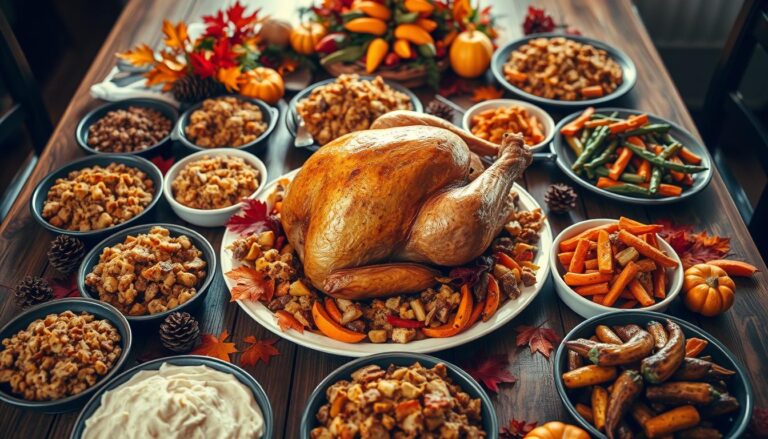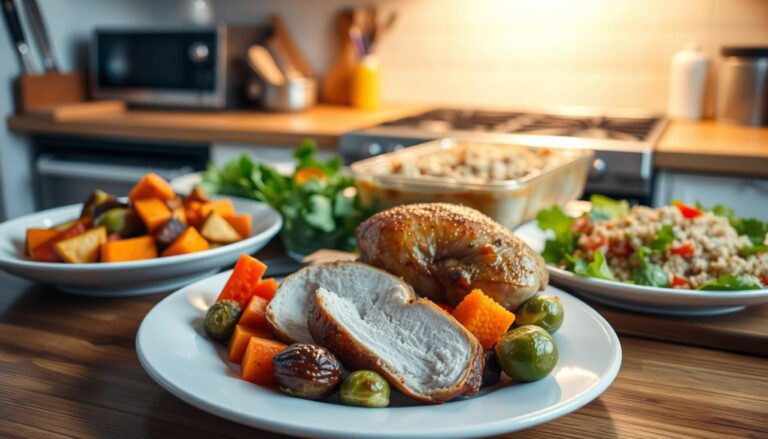7 Savory Turkey Dinner Ideas for Your Next Feast
Are you tired of the same old Thanksgiving recipes year after year? Are you looking for a way to elevate your holiday feast and impress your guests?
The centerpiece of many holiday gatherings is, of course, the star of the plate. For many, that’s a perfectly roasted turkey. But what makes a truly memorable dinner?
With the right holiday dinner ideas, you can transform your next feast into an unforgettable culinary experience. From classic flavors with a twist to entirely new recipes, the options are endless.
Table of Contents
Key Takeaways
- Discover new flavors to elevate your holiday feast
- Explore creative twists on traditional recipes
- Learn how to make your turkey dinner truly special
- Find inspiration for your next holiday gathering
- Get ready to impress your guests with savory delights
The Art of Creating Memorable Turkey Dinners
A perfectly roasted turkey is more than just a meal; it’s an experience that brings people together. The art of crafting a memorable turkey dinner involves combining traditional flavors with modern twists, creating a feast that’s both familiar and exciting.
Why Turkey Remains a Centerpiece for Special Occasions
Turkey has long been a staple of special occasions, particularly in American culture. Its prominence can be attributed to its rich flavor, versatility in preparation, and the tradition surrounding it. Whether it’s Thanksgiving or another celebration, turkey is often the centerpiece of the meal.
Some reasons why turkey remains a favorite include its ability to be prepared in various ways, from roasting to grilling, and its capacity to feed large groups.
Planning Your Perfect Turkey Feast
Planning is key to a successful turkey dinner. Two crucial aspects to consider are the timeline for preparation and the essential equipment needed.
Timeline for Preparation
Creating a timeline helps ensure that your turkey dinner is prepared to perfection without last-minute stress. Here are key steps to include:
- Decide on the recipe and make a shopping list.
- Thaw the turkey well in advance.
- Prepare side dishes according to their cooking times.
Essential Equipment
Having the right equipment is vital for a smooth cooking process. Essential items include:
- A large roasting pan.
- A meat thermometer.
- Sharp knives and cutting tools.
Classic Herb-Roasted Turkey with Gravy
Elevate your holiday meal with a classic herb-roasted turkey, a dish that embodies the essence of comforting, home-cooked cuisine. This timeless roasted turkey recipe is sure to become a staple in your culinary repertoire.
Essential Ingredients for the Perfect Roast
The foundation of a great roasted turkey lies in its ingredients. You’ll need a fresh or thawed turkey, a mix of aromatic herbs like thyme, rosemary, and sage, and some basic pantry staples such as olive oil, salt, and pepper. These ingredients come together to create one of the best turkey dinner flavors.
Step-by-Step Roasting Method
Preheat your oven to 325°F (165°C). Rub the turkey with olive oil, then season with salt, pepper, and your chosen herbs. Place the turkey in a roasting pan and roast until it reaches an internal temperature of 165°F (74°C). Baste the turkey periodically to keep it moist, ensuring a delicious turkey meal.
Making Silky Smooth Gravy from Drippings
After roasting, let the turkey rest before carving. Meanwhile, use the pan drippings to make a rich gravy. Skim off excess fat, then whisk in flour to thicken. Gradually add broth, whisking continuously, until you achieve a smooth, velvety consistency that complements your roasted turkey perfectly.
Maple-Glazed Turkey with Bacon
The combination of maple glaze and bacon takes the traditional turkey dinner to a new level of flavor and sophistication. This creative turkey dish is perfect for those looking to impress their guests at the next holiday dinner.
The Sweet and Savory Flavor Combination
The sweetness of the maple glaze beautifully complements the smoky, savory flavor of the bacon, creating a truly festive turkey recipe. This harmonious balance of flavors elevates the overall dining experience, making it ideal for special occasions.
Bacon-Wrapping Techniques
To achieve a crispy bacon exterior, wrap the turkey breast or thighs with thick-cut bacon slices, securing them with toothpicks if necessary. This technique not only adds flavor but also keeps the turkey moist.
Perfect Maple Glaze Recipe
A simple maple glaze can be made by mixing maple syrup with Dijon mustard and a hint of thyme. Brush this glaze over the turkey during the last hour of roasting for a caramelized, sticky finish.
By incorporating these elements, you’ll create a holiday dinner idea that’s both memorable and delicious.
Spice-Rubbed Smoked Turkey
Elevate your next feast with a spice-rubbed smoked turkey, a dish that combines the rich flavors of smoking with the depth of spices. This method not only enhances the turkey’s natural flavors but also adds a tender, juicy texture that’s sure to impress your guests.
Creating the Ultimate Spice Blend
Crafting the perfect spice blend is crucial for a memorable smoked turkey. A mix of paprika, garlic powder, onion powder, and a hint of cayenne pepper creates a balanced flavor profile that complements the smokiness. Feel free to experiment with different herbs and spices to tailor the blend to your taste preferences.
Smoking Techniques for Beginners
For those new to smoking, it’s essential to start with the basics. Maintaining a consistent temperature is key to achieving evenly cooked meat. Use a meat thermometer to ensure the turkey reaches a safe internal temperature. Wood chips like hickory or applewood are popular choices for smoking turkey, as they add distinct flavors.
Wood Chip Selection for Optimal Flavor
The type of wood chips used can significantly impact the flavor of your smoked turkey. Hickory provides a strong, traditional smoke flavor, while applewood offers a milder, sweeter taste. Experimenting with different wood chip combinations can help you find the perfect flavor for your next gathering.
Citrus and Herb Butter Turkey
Elevate your holiday feast with a Citrus and Herb Butter Turkey, a dish that combines the brightness of citrus with the warmth of herbs. This delicious turkey meal is sure to impress your guests with its moist and flavorful profile.
Crafting the Perfect Citrus Herb Butter
To create the citrus herb butter, mix softened butter with freshly grated citrus zest, chopped fresh herbs like parsley and thyme, and a squeeze of citrus juice. This compound butter not only adds flavor but also helps keep the turkey moist.
Under-the-Skin Application Method
Gently loosen the skin from the turkey breast and thighs, being careful not to tear it. Then, spread the citrus herb butter evenly under the skin, ensuring it’s distributed across the meat. This technique allows the flavors to penetrate deep into the turkey.
Achieving Crispy Golden Skin
To achieve a crispy golden skin, pat the turkey dry with paper towels before roasting. You can also rub the skin with a bit of oil and season with salt and pepper. Roasting the turkey at a higher temperature initially helps to crisp the skin, then reduce the heat to finish cooking.
Wine-Braised Turkey Thighs with Vegetables
Elevate your next feast with wine-braised turkey thighs, a culinary masterpiece that pairs succulent turkey with a medley of vegetables in a rich, wine-infused sauce. This dish is perfect for holiday dinner ideas, offering a unique twist on traditional turkey dinner flavors.
Selecting the Right Wine for Braising
The key to a successful braise is selecting a wine that complements the turkey without overpowering it. A dry red wine, such as Pinot Noir or Merlot, works well, as it adds depth to the dish without making it too acidic. The wine should be of a quality that’s good enough to drink, as its flavors will concentrate during the cooking process.
One-Pot Cooking Method
The beauty of braising lies in its simplicity. By cooking the turkey thighs and vegetables in one pot, you minimize cleanup and maximize flavor. Start by searing the turkey thighs, then add your chosen vegetables and wine, covering the pot to trap the moisture and heat. This method ensures that the turkey remains moist and tender.

Vegetable Pairings that Complement Turkey
Choosing the right vegetables to accompany your braised turkey thighs can elevate the dish. Carrots, onions, and celery are classic choices, providing a flavorful base for the sauce. Other options include parsnips, turnips, or mushrooms, which add texture and variety. The key is to select vegetables that will cook at a similar rate to the turkey, ensuring everything is perfectly done at the same time.
| Vegetable | Cooking Time | Flavor Profile |
|---|---|---|
| Carrots | 30-40 minutes | Sweet, earthy |
| Onions | 20-30 minutes | Sweet, savory |
| Mushrooms | 15-25 minutes | Earthy, umami |
By carefully selecting your ingredients and following a simple one-pot cooking method, you can create a truly memorable braised turkey dish that’s sure to become a new favorite for holiday dinner ideas, showcasing some of the best turkey dinner flavors.
Stuffed Turkey Breast Roulade
Discover the art of creating a mouth-watering Stuffed Turkey Breast Roulade, a dish that combines flavor and visual appeal. This creative twist on traditional turkey recipes is sure to impress your guests and elevate your next feast.
Creative Stuffing Combinations
The key to a great Stuffed Turkey Breast Roulade lies in its filling. Consider combining spinach and feta cheese for a Greek-inspired flavor, or sun-dried tomatoes and basil for a taste of Italy. You can also experiment with wild rice and mushroom mixtures for a hearty, earthy option.
Butterfly and Rolling Techniques
To prepare the turkey breast for stuffing, you’ll need to butterfly it. This involves cutting the breast in half horizontally and opening it like a book. Once your filling is evenly distributed, roll the breast tightly and secure it with kitchen twine. Even rolling is crucial for uniform cooking.
Slicing and Presentation Tips
When it’s time to slice your roulade, use a sharp knife to ensure clean cuts. Slice against the grain to maximize tenderness. For an elegant presentation, arrange the slices on a platter and garnish with fresh herbs. Consider serving with a complementary sauce, such as a cranberry-orange relish.
| Stuffing Combination | Flavor Profile | Recommended For |
|---|---|---|
| Spinach & Feta | Salty, savory | Greek-themed dinners |
| Sun-dried Tomato & Basil | Bright, herby | Italian-inspired feasts |
| Wild Rice & Mushroom | Earthy, hearty | Fall and winter gatherings |
Slow Cooker Turkey and Gravy
Slow cooker turkey is a game-changer for holiday feasts, offering convenience without sacrificing flavor. This method allows you to prepare a delicious, traditional turkey dinner with minimal effort, making it perfect for busy holiday gatherings.
Prep-Ahead Convenience
One of the biggest advantages of using a slow cooker for your turkey is the prep-ahead convenience it offers. You can season the turkey a day in advance and store it in the refrigerator overnight, ready to be placed in the slow cooker the next day. This feature is particularly useful during holidays when kitchen time is precious.
Tips for Prep-Ahead:
- Season the turkey the night before.
- Keep the slow cooker insert in the refrigerator overnight.
- In the morning, simply place the insert into the slow cooker base and turn it on.
Keeping Turkey Moist in the Slow Cooker
To ensure your turkey remains moist, it’s essential to cook it on the low setting and not overcook it. Using a meat thermometer can help you achieve the perfect internal temperature. Additionally, you can add some broth or wine to the slow cooker to maintain moisture and enhance flavor.
“The key to a moist turkey is low and slow cooking,” says culinary expert, Chef John. “It’s all about controlling the temperature and not rushing the process.”
Gravy Thickening Methods
Thickening the gravy is a crucial step in completing your slow cooker turkey dinner. You can use a mixture of cornstarch and broth or flour and fat to thicken the gravy. Another method is to reduce the gravy by cooking it on high for a short period, concentrating the flavors and thickening it naturally.
Gravy Thickening Techniques:
- Mix 1 tablespoon of cornstarch with 2 tablespoons of cold broth until smooth.
- Stir the mixture into the hot gravy and cook until thickened.
- Alternatively, reduce the gravy by simmering it on high for 10-15 minutes.
Turkey Dinner Ideas for Different Occasions
Different occasions call for different approaches to preparing and presenting a turkey dinner, making versatility key to a successful feast.
Thanksgiving Classics with Modern Twists
For Thanksgiving, traditional thanksgiving turkey recipes are always a hit, but adding a modern twist can elevate the classic dish. Consider incorporating unique flavors or ingredients into your holiday dinner ideas, such as a maple glaze or herb-infused butter.
Casual Family Gatherings
For casual family gatherings, a more relaxed approach to cooking turkey can be adopted. Slow cooker turkey recipes are perfect for these occasions, allowing for a hands-off approach while still delivering tender and flavorful meat.
Elegant Holiday Entertaining
When it comes to elegant holiday entertaining, presentation is key. Here, festive turkey recipes that are visually appealing can make a significant impact.
Plating for Presentation
Carefully plating your turkey, perhaps on a decorative platter or with artistic garnishes, can enhance the visual appeal.
Garnishing Tips
Garnishing with fresh herbs or seasonal fruits not only adds color but also complements the flavors of your holiday dinner ideas. Consider using pomegranate seeds or rosemary sprigs to add a festive touch.

Side Dishes That Complement Your Turkey Feast
When it comes to a memorable turkey feast, the right side dishes can elevate the entire dining experience. A well-curated selection of accompaniments not only complements the flavors of the turkey but also adds variety and depth to the meal.
Traditional Accompaniments
Classic side dishes like mashed potatoes, stuffing, and cranberry sauce are staples for a reason. They offer comforting familiarity and pair well with the rich flavors of turkey. For a traditional turkey dinner, these dishes are hard to beat.
Unexpected Pairings That Delight
For those looking to innovate, consider roasted Brussels sprouts with bacon or sweet potato casserole with marshmallows. These unexpected pairings bring a delightful twist to the traditional turkey dinner, offering a mix of flavors and textures that can surprise and please your guests.
Balancing Your Menu
To balance your menu, consider the flavors and textures of your side dishes. A mix of warm and cold, savory and sweet, and soft and crunchy can create a harmonious dining experience. Here’s a simple table to help plan a balanced menu:
| Side Dish Type | Examples | Flavor Profile |
|---|---|---|
| Warm, Savory | Mashed Potatoes, Stuffing | Comforting, Rich |
| Cold, Sweet | Cranberry Sauce, Green Salad | Refreshing, Tangy |
| Crunchy, Savory | Roasted Vegetables, Fried Okra | Crisp, Earthy |
By thoughtfully selecting a variety of side dishes, you can create a well-rounded and memorable turkey feast that showcases the best turkey dinner flavors and delights your guests with creative turkey dishes.
Troubleshooting Common Turkey Cooking Challenges
Cooking a delicious turkey meal can be a challenge, but understanding how to overcome common issues is key to a stress-free dinner.
Preventing Dry Meat
Dry turkey meat is often a result of overcooking. To prevent this, use a meat thermometer to ensure your turkey is cooked to the right temperature. Brining your turkey before cooking can also help retain moisture.
Ensuring Even Cooking
To achieve even cooking, make sure your turkey is thawed and at room temperature before cooking. Regularly basting the turkey and rotating the pan can also promote even browning and cooking.
Timing Your Feast Perfectly
Timing is crucial when cooking a turkey. Use a timer and plan your meal preparation accordingly. Consider the size of your turkey and the cooking method to determine the right cooking time.
Using Meat Thermometers Correctly
A meat thermometer is essential for ensuring your turkey is cooked to a safe internal temperature. Insert the thermometer into the thickest part of the breast and the innermost part of the thigh, avoiding any bones or fat.
Resting Time Importance
After cooking, let your turkey rest for at least 20 minutes before carving. This allows the juices to redistribute, making the turkey more tender and juicy.
Conclusion: Elevating Your Turkey Dinner Experience
With the diverse range of turkey dinner ideas explored, from classic herb-roasted to innovative citrus and herb butter turkey, you’re equipped to elevate your next feast. These best turkey dinner flavors and techniques offer something for every occasion, whether you’re hosting a casual family gathering or an elegant holiday dinner.
By incorporating the provided recipes and tips, you can transform your turkey dinner into a truly unforgettable experience. Experiment with different holiday dinner ideas, such as maple-glazed turkey with bacon or wine-braised turkey thighs with vegetables, to discover new flavors that will delight your guests.
The key to a successful turkey dinner lies in the details, from the perfect roast to the silky smooth gravy. With these ideas, you’ll be well on your way to creating a memorable and delicious turkey dinner that will become the centerpiece of your next celebration.




